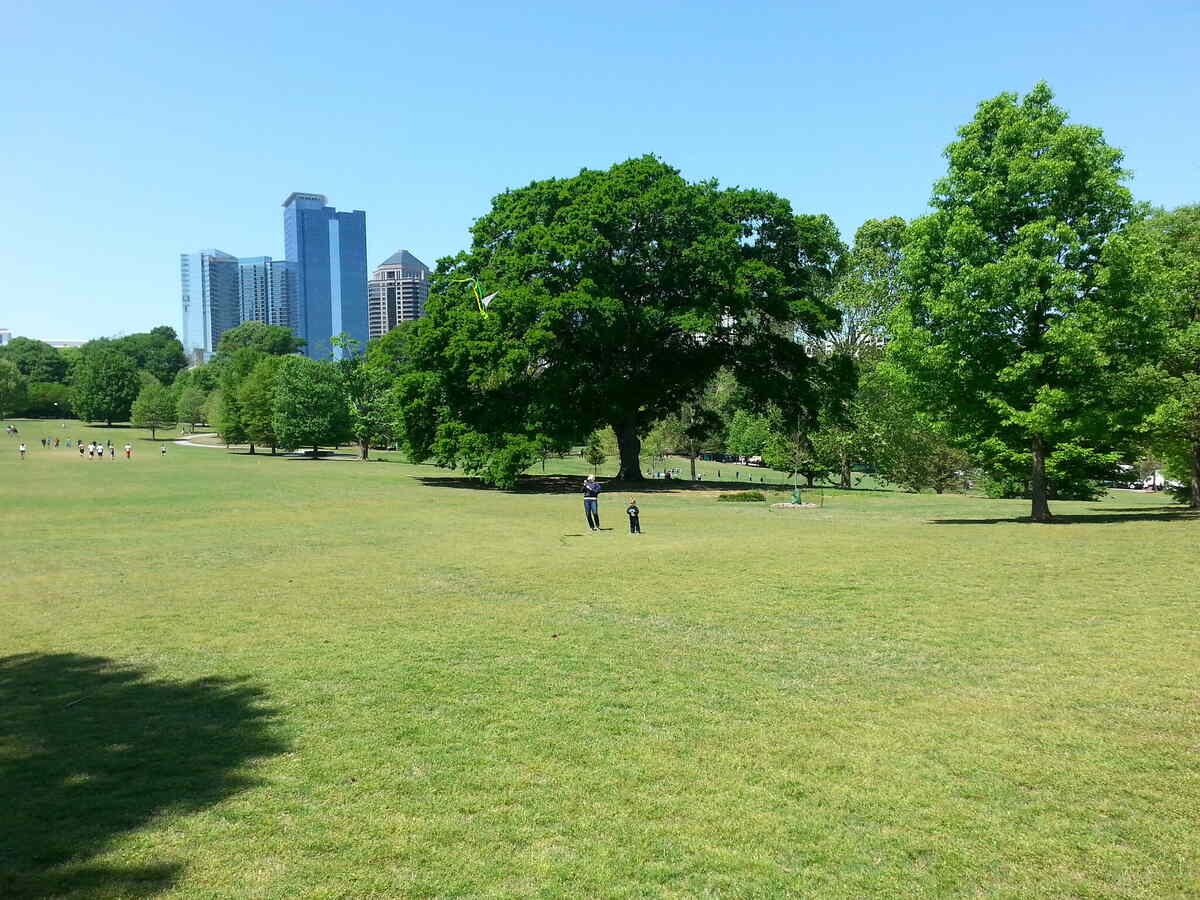
In Atlanta, Georgia, springtime feels different every year. You can get balmy, sunny weather or chilly, wintry days that get you thinking of hot toddies. The one thing you can bet on is the March rain. A little jump in the thermometer and a lot of rainfall usually activate your lawn. It might be that tall fescue is starting to grow or something nastier, like lawn fungi. Sunny or not, come March, it’s time to get your lawn care tools out of the shed and reconnect with your beautiful yard. Here are 13 professional spring lawn care tips for Atlanta to get you started with the right mindset.
- 1. Prepare the Lawn Equipment for a New Season
- 2. Clean-up Your Atlanta Yard
- 3. Consider Scalping the Lawn for Faster Growth
- 4. Dethatch the Lawn if Necessary
- 5. Aerate During Active Growth
- 6. Overseed Warm-Season Grasses
- 7. Take a Soil Test
- 8. Fertilize the Lawn by Grass Type
- 9. Irrigate According to the Atlanta Weather
- 10. Start Mowing
- 11. Apply Herbicides to Prevent Atlanta Lawn Weeds
- 12. Kill Spring Pests
- 13. Prevent and Treat Spring Atlanta Lawn Diseases
1. Prepare the Lawn Equipment for a New Season
Say “Hello!” to a new lawn season in the Big-A! Put your winter tools back in the shed and take out your favorite lawn equipment. Check that everything is in order, and prepare to give your lawn the best spring care. If you’re new to this, here are the essential lawn tools you need to buy, rent, check, or repair:
- Lawn mower
- String trimmer
- Edger
- Blower
- Seed and fertilizer spreader
- Sprinkler system/garden hose
- Shovel
- Rake
- Cutting tools
- Wheelbarrow
Few homeowners decide to buy an aerator or dethatcher since it’s used only once or twice a year. You can rent one at Home Depot for a reasonable price or hire a professional lawn care service for aeration and dethatching.
Checking spring lawn care equipment is easy and can be done in a day. The essential tasks to cover are:
- Lubricate moving parts and hinges.
- Scrape off old clippings and sharpen blades.
- Replace the cutting line on your string trimmer.
- Replace filters.
- Check batteries and power cords on electrical tools.
- Change the oil, spark plugs, and pull-start cord to gas-powered equipment.
- Check and replace any damaged component such as the debris shield on your string trimmer.
Now you’re ready for spring lawn maintenance. Let’s see what tasks you need to cover for a healthy lawn.
2. Clean-up Your Atlanta Yard
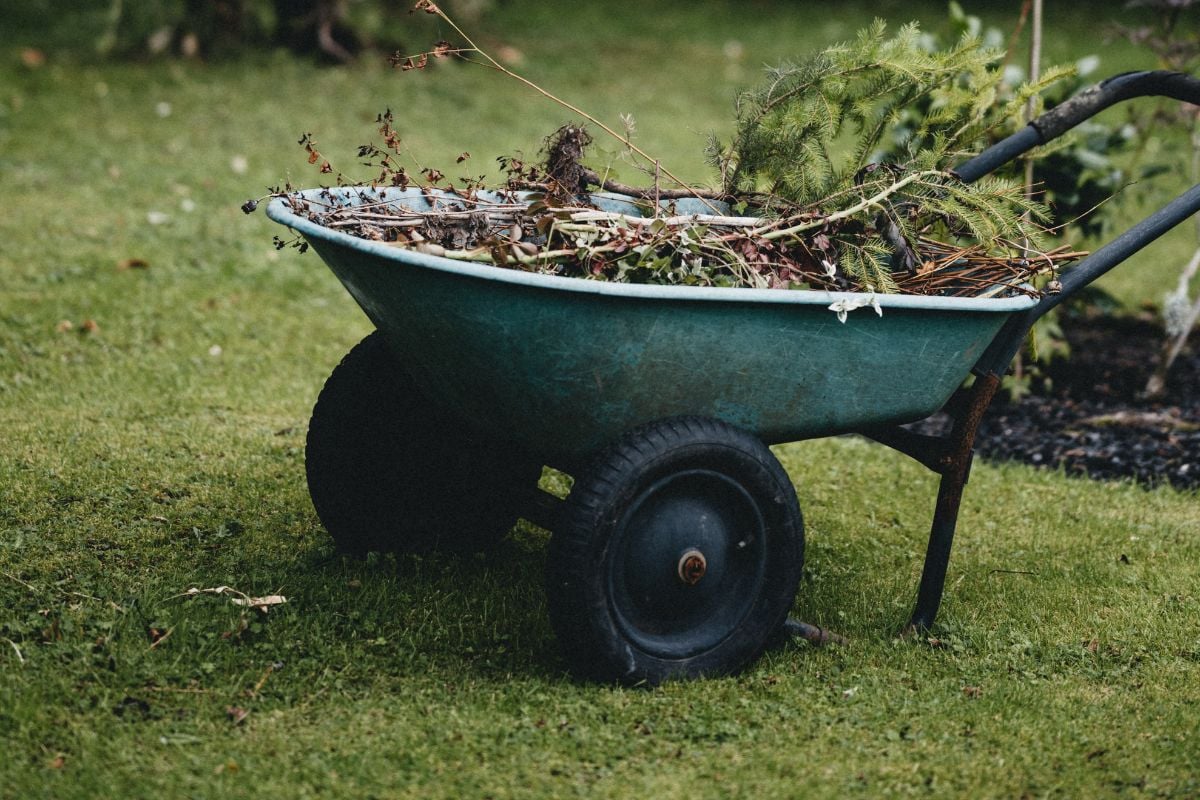
A clean yard is the first condition for healthy, thriving plants, so clean up thoroughly:
- Collect branches, pet waste, rocks, and garbage left behind by the winter snow.
- Rake fallen leaves and other debris and bag them.
- Clean mold and debris from your gutters.
- Trim and prune trees and shrubs.
- Clean up flower beds.
Hire a local landscaping company if you have a large yard and no time to deal with all the spring clean-up work. Professionals are quick and effective and will have the yard ready for the new season in no time.
3. Consider Scalping the Lawn for Faster Growth
Scalping is cutting the grass much lower than usual. It’s best done in the spring when the grass leaves dormancy. Scalping removes the layer of dead grass blades and has valuable benefits for your lawn:
- Free soil warms up easier, absorbs water faster, and speeds up grass growth.
- Removing dead grass blades prevents thatching.
- Scalping helps you see and treat uneven areas and dead spots.
You can hire a lawn care professional to scalp the lawn or take care of it DIY. Here’s what you need to do:
- Scalp your lawn only from early March to mid-April.
- Lower the mower blades gradually. Mow until you trim at the lowest setting (or half as short as you want to maintain your lawn).
- Raise the blades on bumpy areas.
- Bag the grass clippings and dispose of them.
Pro tip: Scalp Bermudagrass and Zoysia. Don’t scalp tall fescue, ryegrass, or Kentucky bluegrass.
4. Dethatch the Lawn if Necessary
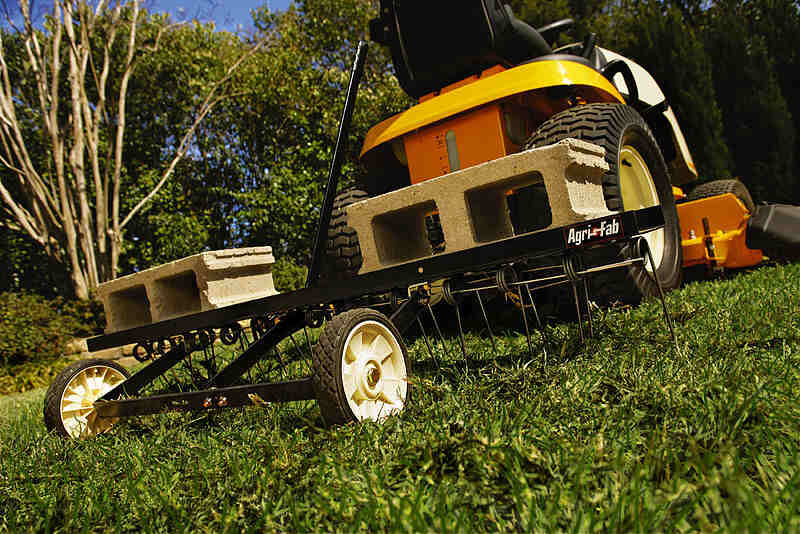
Thatch is a build-up of stems, roots, and leaves that accumulates in a thick layer at the soil’s surface, preventing sun, water, and nutrients from reaching it. Removing it helps the grass grow faster and healthier.
The best time to remove thatch from your Atlanta lawn is during the growing season:
- Early spring for tall fescue and other types of cold-season grass.
- Late spring to early summer for warm-season grasses (after the second mowing of the year, not including scalping).
If you have a monthly plan with a lawn care company, they will typically cover dethatching. Planning to remove the thatch DIY? You can find more information about this in our lawn dethatching guide.
5. Aerate During Active Growth
The Peach State is part of the Piedmont region and has mainly dense clay soil that absorbs water and nutrients slowly. Heavy rain and foot traffic can also lead to more soil compaction over time. Aerating once a year improves drainage by digging out tiny openings in the soil.
The best time to aerate is when the turfgrass is actively growing:
- March and April for tall fescue and other cool-season grasses.
- May through June for warm-season grasses.
This makes aeration a spring lawn care task.
The best way to aerate a lawn is when the soil is moist after a light rain, using a core aerator (you can rent one from Home Depot). Leave the soil plugs on the lawn and break them up with a rake to help them decompose back into the soil. Or, find a landscaping company in the Metro Atlanta area to aerate your beautiful lawn for you.
Pro tip: Spread topsoil to improve soil texture. After aeration is also an excellent time to spread fertilizer.
6. Overseed Warm-Season Grasses
Some Atlanta lawns come out of winter with bare areas or thinning grass. If this is your case, you need to overseed your lawn.
The perfect time to reseed a warm-season lawn is in May – June when these types of grass are actively growing in the Northern Georgia climate. Seeds germinate and grow best on a clean lawn that has been raked, mowed, and aerated.
Pro Tip: When overseeding the lawn, use a starter fertilizer instead of a standard formula and apply it before you spread any grass seed.
7. Take a Soil Test
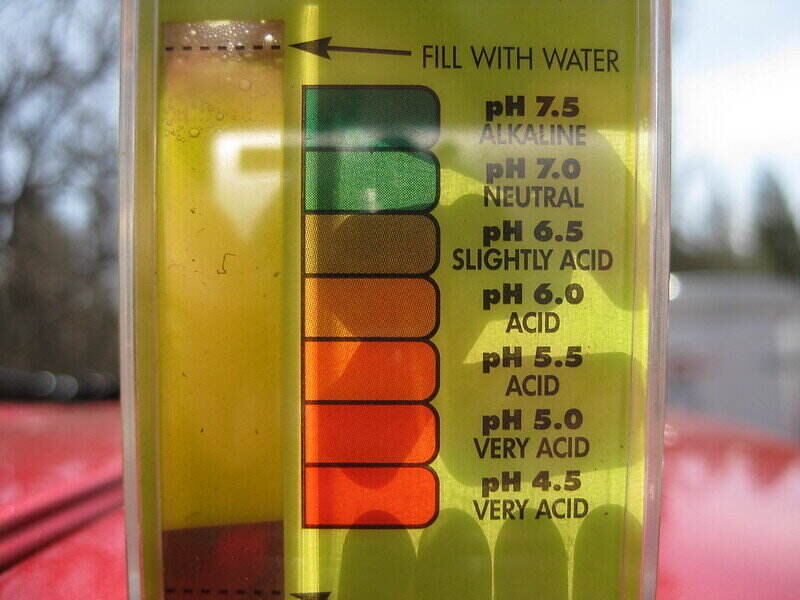
If you haven’t tested your soil as part of the fall lawn care schedule, spring is the next best time to do it.
Check the pH level. It should be between 5.5 and 6.5 to support nutrient absorption and healthy grass. Acidic soil reduces fertilizer efficiency by up to 60%, while alkaline makes the grass more vulnerable to diseases.
You can test your soil at the Fulton County Extension Office for less than $15. The results are ready in about two weeks, including data about soil pH and the primary nutrients your lawn needs, such as:
- Phosphorus
- Potassium
- Calcium
- Magnesium
- Zinc
- Manganese
Pro tip: Atlanta soil usually gets acidic and requires granular lime treatment.
8. Fertilize the Lawn by Grass Type
Spring is one of the best moments to apply fertilizer on your lawn. It can make a huge difference in the grass’s summer look, health, and drought resistance.
For optimum results, use fertilizers during your grass’s growing season, which is different for cold-season and warm-season grasses:
- March for tall fescue and other cool-season grasses
- May for Bermuda, Zoysiagrass, St. Augustinegrass, centipede, and other warm-season grasses
You can fertilize tall fescue a second time in May, if necessary, but no later than that. Fescue slows down its growth during the hot summer, and fertilizing during that time can stress the grass.
The best formula for lawn spring feeding is a granular slow-release high nitrogen fertilizer that:
- Supports new growth.
- Ensures nutrients gradually for many weeks.
- Prevents grass burns from excessive exposure to nitrogen.
How to fertilize your lawn correctly? It’s actually not difficult:
- Wear protective clothing.
- Use a broadcast spreader to ensure a uniform cover.
- Start with the perimeter and continue inwards.
- Since you’re using a slow-release granular fertilizer, irrigate to start the nutrient release.
You can rent a spreader if you don’t own one. Or hire an Atlanta lawn care service to fertilize the lawn and enjoy the results without the hours of extra work.
Pro tip: Test the soil before applying spring fertilizer to ensure you cover any specific nutrient deficiencies.
9. Irrigate According to the Atlanta Weather
Since spring is typically a rainy season in Atlanta, watering the lawn can be tricky. Start irrigating the grass once you apply the first fertilizer feeding, and ensure it receives 1 inch of water per week. This includes both rainfall and what your sprinkler system offers. If it rains, stop irrigating or reduce the amount.
Water deeply and infrequently to build stronger grass roots. The soil should be moist, but the grass should have as little water on the blades as possible. Superficial and frequent watering leads to:
- Shallow grass roots – makes the grass vulnerable to drought.
- Prolonged exposure to moisture – increases the risk of fungi and grass diseases.
- Increased evaporation – less water gets to the grassroots.
The best moment to water your lawn is in the morning, before 10:00 a.m. This gives the soil enough time to absorb as much water as it needs. The rest evaporates with the sun, keeping the grass safe from fungi.
10. Start Mowing
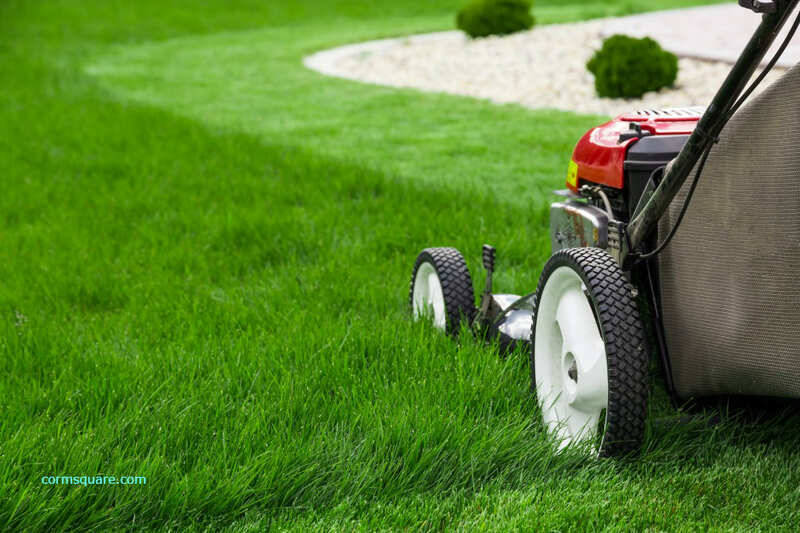
If it’s spring in Atlanta and you have a tall fescue lawn, it’s time to start mowing. You’d typically start in mid-March, but you can pin it down more precisely by measuring the height of your lawn. When it gets 2.5 to 3 inches tall, cut it to keep it at 2 inches for the entire spring.
Warm-season grasses start late, so Bermuda, Zoysia, and St. Augustine lawns need mowing in mid to late May. Here’s how short you should mow Atlanta’s most common turfgrasses:
| Turfgrass Type | Spring Mowing Height |
| Hybrid Bermuda | 1 inch |
| St. Augustinegrass | 2 inches |
| Tall fescue | 2 inches |
| Zoysiagrass | 1 inch |
| Centipedegrass | 1 inch |
You can also opt for professional mowing. Most Atlanta landscaping companies offer weekly or bi-weekly plans and can take care of your lawn.
11. Apply Herbicides to Prevent Atlanta Lawn Weeds
A few nasty weeds threaten Atlanta lawns, and you need a proper weed control schedule to keep them at bay. Come spring, you can:
- Fight annual winter weeds with post-emergent herbicides
- Prevent summer annual and perennial weeds with pre-emergent herbicides
Post-emergent Herbicides and Winter Weeds
Annual winter weeds germinate in late summer or early fall, grow during winter and die in late spring or early summer. Among the most common winter weeds to keep an eye on are:
- Annual bluegrass (Poa annua)
- Speedwell
- Chickweed
- Henbit
- Swinecress
Remove them before they’re able to spread their seeds. Apply a post-emergent herbicide or hand-pick them if there are only a few.
Spring can also bring perennial broadleaf weeds to your lawn. They are difficult to control because they spread by underground structures like:
- Stolons (Common bermudagrass)
- Rhizomes (Red sorrel)
- Tubers (Nutsedge)
- Fleshy taproots (Dandelion)
- Bulbs (Wild garlic)
If you spot them on your lawn in the spring, use a spot-spray post-emergent herbicide to eliminate them.
Pre-emergent Herbicides and Summer Weeds
Spring is also the time to prevent annual summer weeds from spreading. The right time to apply a pre-emergent herbicide is when the soil temperature is 50 to 55°F and the seeds haven’t germinated yet.
Pre-emergent herbicides are usually granular and easily applied around the yard using a spreader. The most common summer weeds to look for in Atlanta lawns are:
- Crabgrass
- Goosegrass
- Lespedeza
- Prostrate knotweed
Pro tip: When applying herbicides, always wear protective equipment, wait for a day without rain or wind, and keep children and pets away from the lawn.
12. Kill Spring Pests
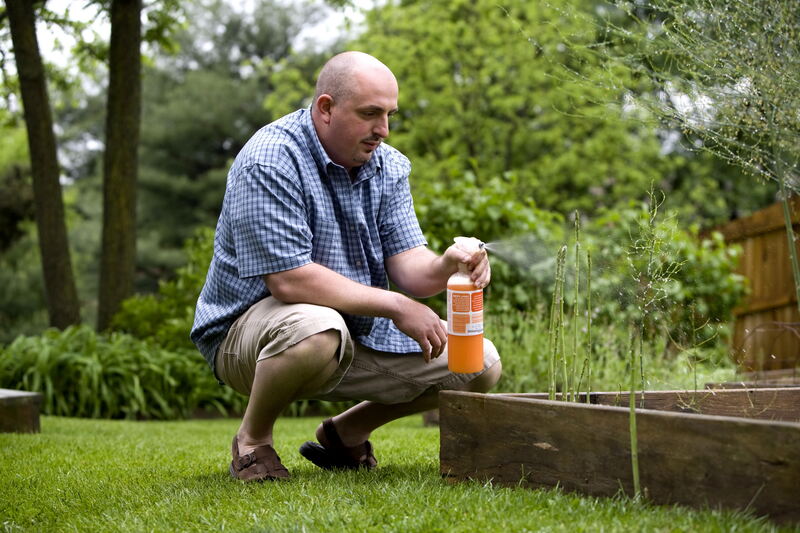
Warmer weather also brings to life pests that can hurt your lawn. Most of them are only eggs in the spring and become dangerous later, but it’s always better to prevent than treat.
Here are the most common lawn pests to consider when caring for an Atlanta lawn:
- Fire ants
- Billbugs
- Chinch bugs
- Ground pearls
- Mites
- Mole crickets
- Slugs/snails
- Spittlebugs
- Turf caterpillars
- White grubs
Keep your lawn clean, healthy, and adequately mowed to prevent pest infestation. Hire a pest control company to remove active infestations effectively.
13. Prevent and Treat Spring Atlanta Lawn Diseases
The humid weather typical to Atlanta springs exposes cold and warm-season lawns to fungal diseases. The most common infestations to watch for this season (like a hawk) are:
| Spring Lawn Disease (Active Months) | What to look for |
| Fairy rings (March to November) | ● Rings of brown and wilted dead grass ● Rings of tall, dark green grass |
| Brown patch (February to June) | ● Rings or circular patches of blighted turfgrass ● Reddish-brown or black leaf spots“Smoke-rings” – thin, brown borders around the diseased patches ● Leaves pull out easily; roots are not affected |
| Large patch (March to May) | ● Circular patches of brownish turf, orange at the periphery ● Leaves dieback from the tip toward the base |
| Dollar spot (February to December) | ● Sunken, circular patches of grass, brown to straw color, measuring up to several inches ●Small lesions on the leaves, yellow-green to straw color, with a reddish-brown border |
| Leaf spot/Melting out (March to November) | ● Leaf blades and sheath have purplish-brown to black spots with tan centers ● The lower leaves are withered and blighted |
| Anthracnose (April to July) | ● Reddish-brown spots surrounded by a yellow halo ● Basal stem and leaf sheath rot ● Infected shoots detach easily |
| Gray Leaf Spot (June to September) | ● Oval or elongated bluish-gray spots on St. Augustinegrass; the mature lesions are tan to gray, with depressed centers and irregular, purple-to-brown margins ● Symptoms are similar to melting out disease in cold-season grasses |
| Pythium root rot (all year round) | ● Yellow, irregularly shaped patches ● Turfgrass is thin, off-color, and slow-growing |
| Slime mold (March to May, September to November) | ● Pinhead-sized fruiting bodies on grass blades and stems in circular to irregular patches 1-30 inches in diameter ● Slimy or crusty substance covering the grass |
Fungal diseases thrive in lawns that are not maintained correctly. They develop easier and faster in yards with:
- Compacted soil with poor drainage
- Excessive moisture
- Build-up of organic matter, either thatch or extensive tree and shrub roots still in the ground
- Unbalanced soil with not enough nutrients or an excessive amount of nitrogen
The best way to prevent disease is to keep a healthy lawn. For an Atlanta lawn in the spring season, this means:
- Aerate if the soil is compacted and dethatch if roots, stems, and leaves build up on the soil’s surface.
- Water correctly: early morning (avoid evening irrigation), deeply and less frequently to reduce the time when grass blades are wet. Stop irrigating or irrigate less if it rains.
- Shake down the dew from the grass canopy early in the morning using a hose (don’t do this if the lawn is already infested, you’ll help it spread faster).
- Test the soil and add slow-release fertilizer to ensure a balanced fertility level.
- Keep the soil pH at a 5.5 to 6.5 interval. Add lime to correct if the soil is too acidic and sulfur if too alkaline.
- Trim and prune trees and shrubs to increase sunlight exposure if you have a warm-season grass lawn.
While a fungal disease is active on your lawn, AVOID:
- Core aeration
- Herbicides
- Fast-release liquid fertilizers
- Foot traffic across the yard (it stresses the grass and can spread the infection)
Bag the clippings and dispose of them while the lawn is in treatment to avoid spreading the fungi. Find a landscaping company in Atlanta to help you identify the disease affecting your property and apply the proper fungicides.
FAQ
Add fertilizer when your grass is actively growing. In Atlanta, Georgia, this means:
● March for tall fescue
● May for warm-season grasses such as Bermuda, Zoysia, St. Augustine, and centipede
Apply fertilizer in early spring only if you planted cold-season grass. It’s the best time for a slow-release, granular, green-up fertilizer:
Rich in nitrogen that supports new leaf growth
Low in phosphate
Moderate in potassium to help the roots
If you want to switch to eco-friendly lawn care maintenance, use organic fertilizer. Organic formulas are lower in nitrogen than synthetic alternatives, so you’ll need to apply more. They are also slow-release and feed the lawn gradually, preparing the soil and plants for the summer.
Enjoy Your Beautiful Atlanta Lawn Today!
Taking care of your Atlanta lawn correctly in the spring prepares the field for a lush, green lawn in the summer. It’s the best time to aerate, fertilize and protect the grass from pests, weeds, and fungi.
It’s also a lot of work; you need to do it right, so don’t hesitate to get help. Most professional lawn care services include a spring package. Contact a trustworthy lawn care company in Atlanta and enjoy watching your grass grow healthy and thick without the extra work!
Main Image Credit: Nate Shivar / Flickr / CC BY 2.0